Chapter 16.pptx
advertisement
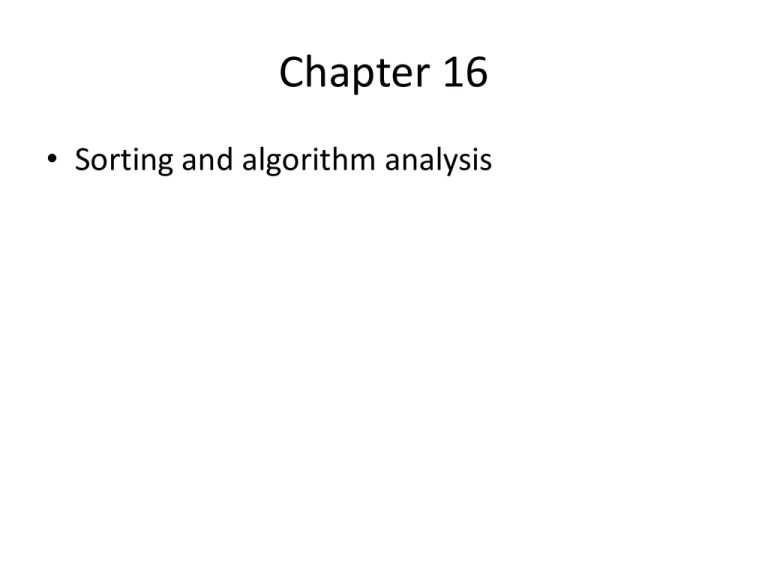
Chapter 16
• Sorting and algorithm analysis
Chapter 16 part 1
Some Sort Algorithms
•
•
•
•
Bubble Sort
Selection Sort
Insertion Sort
Quicksort
"Seeing" as an algorithm "sees" data
• When we "look" at a data set, we tend to
"see" the data set in parallel, "all at once".
• We need to train ourselves to "see" as a
computer sees things, pretty much "one item
at a time".
• It takes a little discipline to answer the
question "what would I do next, if I had only a
computer's limited vision?"
Bubble Sort
• for (maxE=a.length-1;MaxE >=0; MaxE--) {
for (i=0; i<maxE; i++ ) {
if (a[i) > a[i+1]) swap(a,i,i+1);
}
}
static void swap(int[] a,i,j) {
int temp;
temp = a[i];
a[i] = a[j];
a[j] = temp;
}
• Note: each pass of inner loop "bubbles" the largest to
the end.
Selection Sort
• A key concept: the "currently biggest (or smallest)
one".
• When we are starting out, looking at the first
item, it is the "currently biggest one".
• We examine every other element, one at a time,
and ask the question: Is it bigger than the
currently biggest one?
– If it is, it becomes the "currently biggest one".
• Since we have to examine every item in the list, it
is easy to see that this is "order n" (more on that
later).
Selection Sort
• for (i=0;i<a.length-1;i++) {
locMin = i;
for (j=i+1; j<a.length; j++) {
if (a[j] < locMin) locMin = j;
}
if (locMin != i) swap(a,i,locMin);
}
• Fewer swaps than bubble sort.
Insertion Sort
• This is how you pick up a hand of cards.
• Appropriate data structures make it easy to
implement
• With inappropriate data structure, this may
involve a lot of data-moving.
• Conceptually, create an (empty) "sorted subset"
one-by-one, add elements from the unsorted
array, adding each one in the right place so that
the "sorted subset" remains sorted.
Quicksort
• Invented in 1960
• First widely-used algorithm to break the n2
barrier
• It is a fundamentally recursive algorithm
• The partition method is at the heart of the
algorithm
Partition method of Quicksort
• Find some arbitrary member of the array.
• Call it the pivot value
• Rearrange the array so that the array is
partitioned by the pivot value
– All members lower than the pivot are before it.
– All members higher than the pivot are after it.
A partitioned array
• After partitioning, an array is three sub-arrays:
– A sub-array where all the members are lower than
the pivot (note: this sub-array is not initially
sorted)
– A single-member array (the pivot itself)
– A sub-array where all members are higher (or
equal to) the pivot
Completing the Quicksort
• After the array is partitioned, all we have to do is
re-arrange the first sub-array and last sub-array
so they are both sorted.
• A recursive call on each of these does this.
• For randomly mixed data, Quicksort performs at
nLog(n) speed, though it can be as bad as n2 for
partially-sorted input.
• Many other sorting algorithms are variations of
Quicksort. They strive to keep themselves
nLog(n).
Sequential Searching
• Look at each item, one at a time, and ask: "Is
this the one we are looking for?"
• On average, we look at n/2 items before we
find the one we are looking for.
• If our target is at the end of the list, or not
there at all, we "look at" all n items.
• There is no expectation about the order of the
items in which we are searching.
The Binary Search
• This is for searching into a sorted data structure.
• It is essentially the "game of 20 questions".
– Let's play the game.
– One person generates a random integer in the range
0-1,000,000
– The other attempts to guess the number in 20 "yesno" questions
– begin with "Is it greater than 500,000?"…
• You can always win because 1,000,000<220
Binary Search
• Just apply the "20 questions" strategy to a
search.
• Iteratively (or recursively) divide the data
structure into halves.
Chapter 16 part 3
Analysis of Algorithms
• Experiment vs. analysis
• Limits of experiment
– measures programs vs algorithms
– depends on language, compiler, operating system.
– depends on specific input
Computational Problems & Basic Steps
• A computational problem is a problem to be
solved using an algorithm.
– a collection of instances.
– Size of an instance refers to the memory required
– A Basic Step is can executed in time bounded by a
constant regardless of the size of the input. (e.g.
Swap two integers)
– contrast to find the largest element in an array.
This not basic, it depends on the size of the array.
Complexity of Algorithms
• Consider a sequential search.
• Worst case complexity.
– sequential search: n
– Binary search: k*log(n)
– Selection sort: 1+2+3+…n-1 = (n-1)*n/2 n2/2
• Average case complexity can be used if the
relative frequencies (distributions) of the
different inputs are likely to occur in practice
are known.
Asymptotic Complexity
f ( x)
3n 5n
lim
lim
2
g ( x ) x
n
x
2
lim
x
lim 3
x
5
3
n
3n
1
5n * 2
n
1
n2 * 2
n
2
Big O notation
•
•
•
•
•
•
•
f(n) is in O(g(n)) if f(n) ≤ Kg(n) for n≥1 and some K.
O(1): constant time
O(log n) : logarithmic time
O(n): linear time
O(nlog n): "n log n" time
O(n2): "n squared time"
Union of O(n1) O(n2) O(n3)…: Polynomial
Time
• N-P – Non-polynomial
N-P – Non-polynomial time
• Travelling salesman problem
• Factor the product of two big primes
• These problems can form a class of "easy to
do, but very hard to undo" problems.
• Such situations are the basis of practical
cryptography.

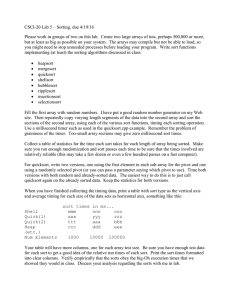
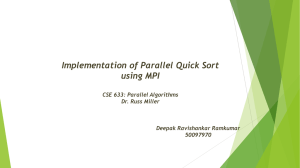
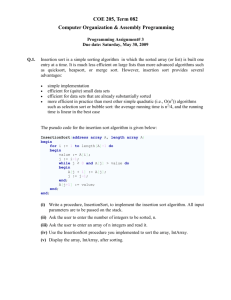
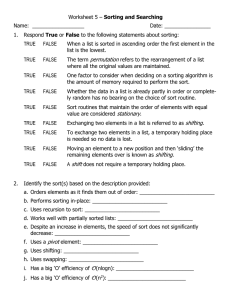
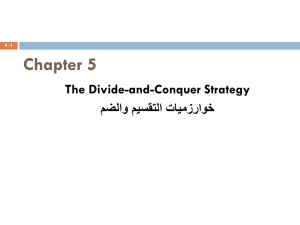
![Problem 1 (Maximum Subarray). Given an array A[1,n] such that A[i](http://s2.studylib.net/store/data/018261657_1-81df34d7a98168d618c800e680a27a3f-300x300.png)